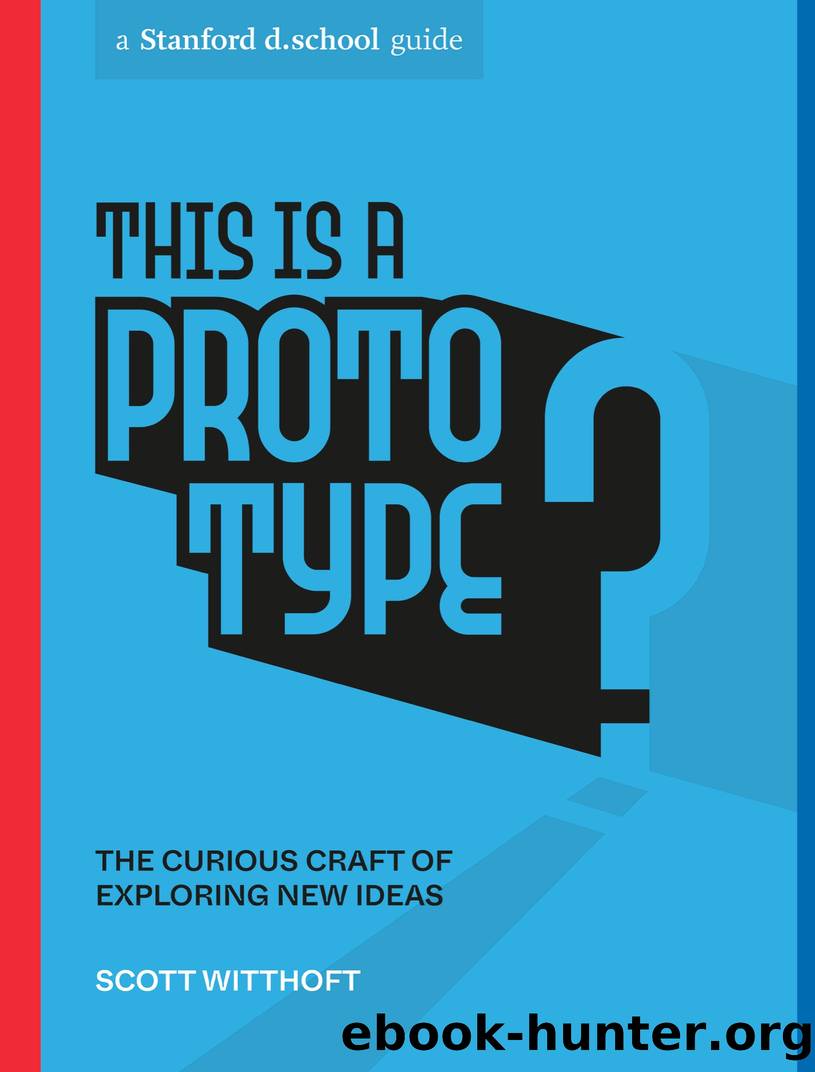This Is a Prototype by Scott Witthoft & Stanford d.school

Author:Scott Witthoft & Stanford d.school [Witthoft, Scott & Stanford d.school]
Language: eng
Format: epub
Publisher: Clarkson Potter/Ten Speed
Published: 2022-10-04T00:00:00+00:00
Both sets of prototypes resembled âlooks likeâ and âworks likeâ levels of resolution. They elicited actual behaviors in people who were otherwise going about their real-life routines. These experiences were provocative by nature but functionally different from an equivalent protest, speech, or presentation. By being physical and experiential, they moved beyond conversations and thoughts about policy to actual changes in policy.
These examples demonstrate how questions can be explored and embodied through prototypes. How are public streets used? How might streets be divided, shared, or separated for different modes of transportation? What does it mean to prioritize bicycle traffic? How can perceived dangers be visualized for a shared understanding? What does it look like to implement some âfirst draftâ solutions? What can we learn from low-resolution versions of barriers, visual indicators, rearrangement of patterns? After successful explorations, what would the next-step versions be? What do we see not working with these quick installations, and what would be the next iteration? Every âbuiltâ element could easily have been much higher in resolutionâbigger, stronger, more durableâbut the context of the exploration was not at that level, yet.
We can pick out the familiar principles from these examples and see how they can guide your own decisions:
Abandoning the burden of perfectionism and using only what is needed helps make the outcomes clearer.
Creating an immersive context with details that feel real leads to authentic reactions from people, instead of pretend or projected answers.
Allowing people to engage with and, in some cases, change the details in front of them can inform the questions you are posing and illuminate new questions you havenât yet considered.
Each of these elements is a helpful step in turning anything that you have made into an evaluative experience instead of an object on a shelf.
Prototype from Precedent
Stockpiling experience examples, like the ones just presented, offers the same benefit as gathering building blocks did in chapter 2. These examples, whether devised by you or someone else, are perfect for adapting for future use. Recasting concepts in a new way can feel a bit odd at first, but itâs not a frivolous effort. You can approach previous prototype experiences with the same calculation as a lawyer seeking legal precedents to prepare for a case. While details might differ, there is something to be learned from previous situations that you can borrow or bend into a new way forward.
Stewart Brand, a do-it-yourself pioneer and founder of The Whole Earth Catalog, describes an architectural design principle called âadaptive reuse.â It suggests that the built environment, consisting of structures of all kinds, experiences different lives based on the circumstances of the day. What was once a hospital may turn into a luxury hotel. A warehouse may transform into a high school; a main street into a farmersâ market. You can adapt this circular behavior and its intent: collect experiences to reuse as raw materials for building out new ideas and opportunities.
The following Experience Catalog features a few best practices for creating prototype experiences. These examples serve a
Download
This site does not store any files on its server. We only index and link to content provided by other sites. Please contact the content providers to delete copyright contents if any and email us, we'll remove relevant links or contents immediately.
| Bookkeeping | Business Mathematics |
| Business Writing | Communications |
| Decision Making | Negotiating |
| Project Management | Running Meetings & Presentations |
| Secretarial Aids & Training | Time Management |
| Training |
Nudge - Improving Decisions about Health, Wealth, and Happiness by Thaler Sunstein(7655)
Deep Work by Cal Newport(6962)
Principles: Life and Work by Ray Dalio(6296)
The Doodle Revolution by Sunni Brown(4713)
Factfulness: Ten Reasons We're Wrong About the World – and Why Things Are Better Than You Think by Hans Rosling(4712)
Eat That Frog! by Brian Tracy(4479)
Thinking in Bets by Annie Duke(4184)
Hyperfocus by Chris Bailey(4086)
Visual Intelligence by Amy E. Herman(3752)
Writing Your Dissertation in Fifteen Minutes a Day by Joan Bolker(3696)
Ogilvy on Advertising by David Ogilvy(3550)
How to Win Friends and Influence People in the Digital Age by Dale Carnegie & Associates(3518)
Hidden Persuasion: 33 psychological influence techniques in advertising by Marc Andrews & Matthijs van Leeuwen & Rick van Baaren(3516)
How to win friends and influence people by Dale Carnegie(3437)
The Pixar Touch by David A. Price(3389)
Schaum's Quick Guide to Writing Great Short Stories by Margaret Lucke(3342)
Deep Work: Rules for Focused Success in a Distracted World by Cal Newport(3182)
Work Clean by Dan Charnas(3078)
The Slow Fix: Solve Problems, Work Smarter, and Live Better In a World Addicted to Speed by Carl Honore(2975)
